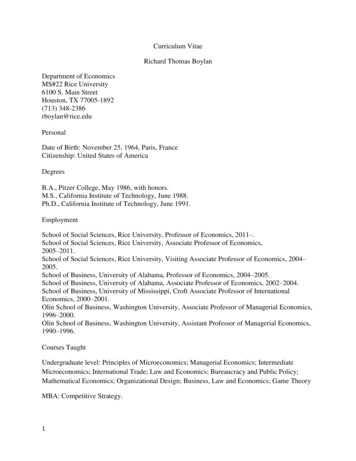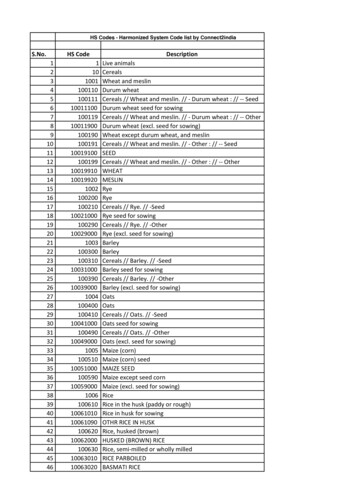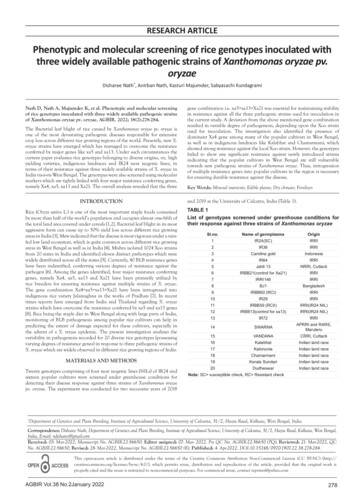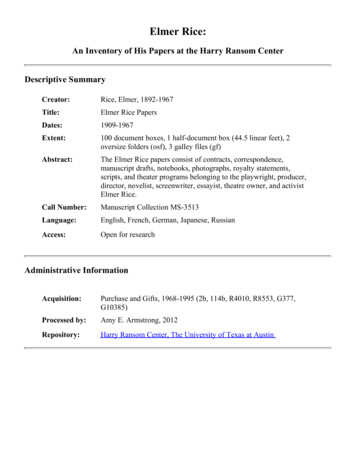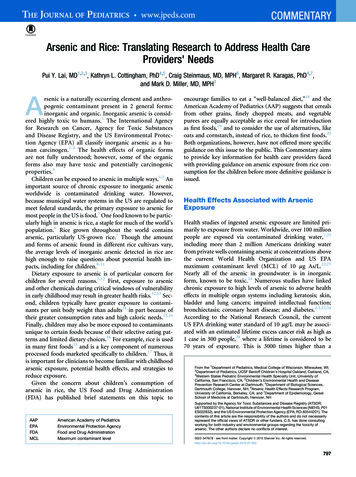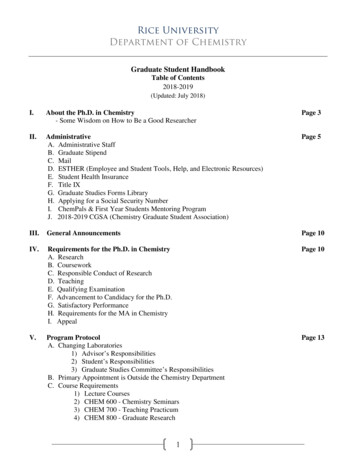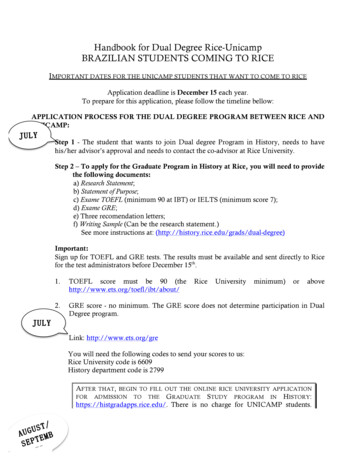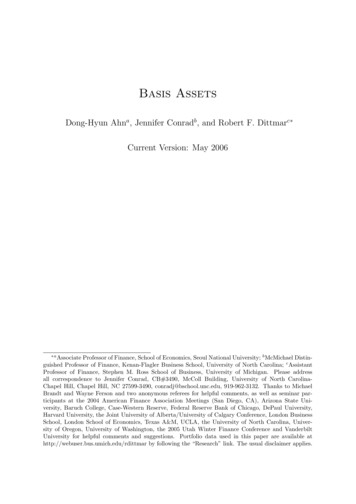
Transcription
Basis AssetsDong-Hyun Ahna , Jennifer Conradb , and Robert F. Dittmarc Current Version: May 2006 aAssociate Professor of Finance, School of Economics, Seoul National University; b McMichael Distinguished Professor of Finance, Kenan-Flagler Business School, University of North Carolina; c AssistantProfessor of Finance, Stephen M. Ross School of Business, University of Michigan. Please addressall correspondence to Jennifer Conrad, CB#3490, McColl Building, University of North CarolinaChapel Hill, Chapel Hill, NC 27599-3490, conradj@bschool.unc.edu, 919-962-3132. Thanks to MichaelBrandt and Wayne Ferson and two anonymous referees for helpful comments, as well as seminar participants at the 2004 American Finance Association Meetings (San Diego, CA), Arizona State University, Baruch College, Case-Western Reserve, Federal Reserve Bank of Chicago, DePaul University,Harvard University, the Joint University of Alberta/University of Calgary Conference, London BusinessSchool, London School of Economics, Texas A&M, UCLA, the University of North Carolina, University of Oregon, University of Washington, the 2005 Utah Winter Finance Conference and VanderbiltUniversity for helpful comments and suggestions. Portfolio data used in this paper are available athttp://webuser.bus.umich.edu/rdittmar by following the “Research” link. The usual disclaimer applies.
AbstractThis paper proposes a new method of forming basis assets. We use returncorrelations to sort securities into portfolios and compare the inferences drawnfrom this set of basis assets with those drawn from other benchmark portfolios.The proposed set of portfolios appears capable of generating measures of risk-returntrade-off that are estimated with lower error. In tests of asset pricing models, wefind that the returns of these portfolios are significantly and positively related toboth CAPM and CCAPM risk measures, and there are significant components ofthese returns which are not captured by the 3-factor model.
1IntroductionA fundamental object in asset pricing is the investment opportunity set, the set of assetsthat investors use in making portfolio decisions. The pioneering work of Markowitz(1952), Cass and Stiglitz (1970) and Ross (1978) shows that this set can be reduced to agroup of portfolios that dominate the opportunity set represented by individual assets.The subsequent empirical literature that tests the implications of asset pricing models hasused this insight to focus on models’ ability to describe the returns on a relatively smallset of portfolios rather than a large number of individual assets. The implicit assumptionin this literature is that the portfolios analyzed span the ex ante opportunity set availableto investors. We term this representative set of portfolios a set of basis assets.In recent years, it has become increasingly common to use size- and book-to-marketsorted portfolios as basis assets, and ask whether asset pricing models can explain thedispersion in the returns on these portfolios. Forming portfolios based on these characteristics has the advantage that it generates a large dispersion in returns, and hencepresents a challenge to any asset pricing model. Fama and French (1996), for example,show that their three-factor model can explain more than 90% of the returns of theseportfolios, and that the unexplained portion of returns is economically small. However,the practice of using characteristic-sorted portfolios as basis assets has sparked a debateabout whether they are appropriate to use in order to draw inferences about asset pricingmodels. Cochrane (2001) advances the opinion that such a procedure is precisely whatresearchers should do, as this approach generates dispersion in expected returns alongdimensions of interest. In contrast, Lo and MacKinlay (1990) suggest that sorting oncharacteristics that are known to be correlated with returns generates a data snoopingbias.1 Conrad, Cooper, and Kaul (2003) show that the increasing tendency of researchersto sort on multiple characteristics, and consequently form larger numbers of portfolios,exacerbates the data-snooping bias. In this case, the dispersion may weaken or disappearin out-of-sample tests because the relation between returns and the characteristic is notrobust over time.In addition to the concern about data-snooping, Daniel and Titman (2005) argue thatfirm characteristics such as book-to-market equity serve as a ‘catch-all’, and capture differences in the sensitivities of firms’ returns to a number of different fundamental factors.1Berk (2000) and Kan (1999) extend this analysis to consider sub-sorts within groups of characteristicsorted portfolios. These authors suggest that the characteristics upon which researchers sort, such assize, may be mechanically related to expected returns.1
Consequently, asset pricing model tests on size- and book-to-market-sorted portfolios willfind that factors based on these characteristics are important, but are unable to informus as to the importance of other, perhaps more fundamental factors, because there is insufficient variation along any other specific factor in these portfolios. Daniel and Titmango on to argue that a new set of portfolios is required if statistical tests of asset pricingmodels are to have sufficient power to reject the model, or identify important factors. AsJagannathan and Wang (1996), p. 36 suggest, “. we need to devise methods for evaluating the economic importance of the data sets used in empirical studies of asset-pricingmodels.”In this paper, we suggest a particular approach for forming basis assets that we argueis well-motivated economically, alleviates some of the problems inherent in the usualapproaches to forming these assets, and may have the ability to generate more informativetests of asset pricing models. The method that we propose focuses on the properties ofthe covariance matrix of returns rather than the ex post vector of mean returns. Thisfocus is sensible since the covariance matrix is the central object in the portfolio theorypioneered by Markowitz (1952). In particular, we suggest that the appropriate sortshould attempt to group (separate) firms that are highly (less) correlated, as opposed togrouping firms that have similar realized returns. We utilize a correlation-based distancemeasure to form portfolios. In focusing on the covariance matrix as an interesting objectfor economically differentiating sets of basis assets, we also examine an important, butlittle discussed, characteristic of sorted portfolios: the conditioning of the covariancematrix formed by the basis assets. This feature of the covariance matrix is a criticaldeterminant of the precision with which any inferences related to the basis assets can bedrawn.We use cluster analysis and a distance measure proposed by Ormerod and Mounfield(2000) to sort firms into portfolios. A small number of these portfolios generates significant dispersion in subsequent returns: the spread in average returns when ten clusterportfolios are formed is 47 basis points per month. This dispersion in mean returns iscomparable to, or better than, that observed in the ten size-, book-to-market- or betasorted portfolios, of 51, 54 and 18 basis points per month, respectively. When 25 clusterportfolios are formed, the spread in mean returns increases substantially to 79 basispoints per month; this large dispersion is accompanied by substantially higher volatilityof returns. In general, the maximum Sharpe ratio of the opportunity set formed from cluster portfolios is somewhat smaller than the maximum Sharpe ratios of the opportunityset formed using characteristic-sorted portfolios. Nonetheless, these results suggest that2
forming benchmark assets using the past co-movement of individual securities’ returnscan generate significant differences in future returns, without the potential data-snoopingbias associated with the use of characteristics that have already been shown to be relatedto dispersion in returns.We present the results of a battery of tests to gauge the statistical and economicadvantages and weaknesses of this alternative method of estimating the investor’s opportunity set. We show that the clustering procedure generates significantly smaller correlations across portfolios than characteristic-based sorting methods. As a consequence, thecluster portfolios’ covariance matrix is better conditioned than the alternative portfolios.We examine the implications of the relative conditioning of the different sets of basisassets for asset pricing inferences. The relatively poor conditioning of the characteristicsorted basis assets leads to efficient frontiers which are more sensitive to small changesin the data. In contrast, the cluster portfolios, with their better conditioning, generateinferences that are relatively insensitive to small perturbations in the data. In addition,measurement error in the data is associated with a positive bias in the Sharpe ratio,and we find that this bias is larger for basis assets (such as size-sorted portfolios) whosecovariance matrix is relatively ill-conditioned.Finally, we compare the inferences drawn from the cluster portfolios to those drawnfrom size- and book-to-market sorted portfolios using two standard approaches in theempirical literature. First, we perform Gibbons, Ross, and Shanken (1989) tests to gaugethe performance of the CAPM and the Fama and French (1993) three-factor model indescribing the returns on the two sets of basis assets. The Gibbons, Ross, and Shankenspecification test suggests that the models perform similarly using both the cluster andcharacteristic-sorted portfolios. However, we observe larger pricing errors, and a relativelypoor model fit, in the individual cluster portfolios compared to the characteristic-sortedportfolios. That is, there appear to be some features of the cluster portfolios returnswhich cannot be explained by the CAPM or the three-factor model.Second, we use cross-sectional regression tests to test the CAPM, consumption CAPM(CCAPM), three-factor model, and the conditional CAPM of Jagannathan and Wang(1996) on the cluster portfolios and characteristic-sorted portfolios. Generally, we findstrong evidence that traditional risk measures, such as CAPM and CCAPM betas, aresignificantly and positively related to cluster portfolio returns; this result is robust to theinclusion of firm characteristics such as size and book-to-market. Further, the conditionalspecification in Jagannathan and Wang (1996) describes a large portion of the crosssectional variation in average returns on the cluster portfolios. However, the three Fama3
and French (1993) factors explain virtually none of this variation. In contrast, when sizeand book-to-market sorted portfolios are used as basis assets, only the characteristicsand their factor-mimicking portfolio risk exposures are significantly related to returns;traditional beta risk measures are significantly negatively related to the returns of theseportfolios when characteristics are included.Despite the characteristics’ lack of explanatory power in specification tests using thecluster portfolios, we show that the cluster portfolios exhibit significant cross-sectionaldifferences in size and book-to-market, as well as CAPM beta. This evidence suggeststwo conclusions. First, it indicates that there is sufficient dispersion in the characteristicsto enable a powerful test of the relation between cluster portfolio returns and thesecharacteristics. Second, the evidence provides insight into the question of whether thecharacteristics are related to the co-movement that determines the cluster grouping. Theresults suggest that the co-movement that determines membership in a particular clusteris related to fundamental economic characteristics of the firm.The remainder of the paper is outlined as follows. In Section 2, we discuss thetheoretical reasoning underpinning the formation of basis assets for asset pricing tests.In addition, the specific clustering procedure following Ormerod and Mounfield (2000)is discussed. Section 3 describes the data that we use, and examines the effects ofdifferences in the conditioning of covariance matrices on test results, Section 4 examinesthe economic differences associated with different sets of basis assets when testing assetpricing models, Section 5 describes differences in the average characteristics of the clusterportfolios and Section 6 concludes.22.1Forming Basis AssetsDefinition of the BasisThe challenge that we consider is to find a set of portfolios that best characterizes aninvestor’s opportunity set, consisting of all marketed securities as the basis assets. Practical constraints, including econometric problems, data availability, and computationalresources, prevent researchers from considering the entire set of marketed claims. Instead, the opportunity set is reduced to a “representative set” of portfolios that seeksto approximate the investor’s opportunity set as well as possible. In typical applications, researchers analyze between 10 and 100 portfolios of stocks in order to judge the4
opportunity set available to investors or to analyze pricing models.Various rules for the division of assets in portfolios have been proposed in the literature. These rules are based on firm-specific characteristics that are hypothesized to berelated to dispersion in expected returns, or on characteristics that have been shown to berelated to dispersion in subsequent realized returns. Using characteristics, rather thanvariables that a particular theory implies are related to expected return, is appealinginsofar as the procedure generates dispersion in returns (and therefore empirical powerin tests of asset pricing models). The principal difficulty with using characteristics thatare known to be related ex post to mean returns is that this procedure induces a datasnooping bias. In Lo and MacKinlay (1990), for example, the authors argue that one willalways be able to find ex post deviations from a “true” asset pricing model and, moreover,that such biases will appear to be significant when they are considered in a group. Consequently, finding that firm characteristics are related ex post to average returns and thengrouping firms into portfolios based on these characteristics may constitute a groupingof ex post deviations from a pricing model. Unfortunately, the magnitude of this bias isdifficult to quantify in practice. MacKinlay (1995) presents evidence that suggests thatthis bias may be quite severe in the context of size- and book-to-market portfolios.Consequently, the decision about the choice of basis assets in an asset pricing testposes a significant conundrum for the researcher. On one hand, the researcher couldchoose a set of variables which are ex ante related to expected returns on the basis ofa theoretical model of asset prices. However, if the model is not correctly specified orreturns are sufficiently noisy, these variables may have no significant relation to estimatesof expected returns and, consequently, generate insufficient dispersion in returns for theempirical tests to have power. In contrast, sorting on the basis of characteristics knownto be related to ex post returns generates dispersion in average returns, lending apparentpower to the test of the asset pricing model. However, data snooping issues limit theconclusions that one can draw from such tests. And, as a practical matter, the abilityof some characteristics to produce dispersion in returns can vary substantially throughtime. For example, much of the well-known relation between size and returns appearsto evaporate after 1985. A similar effect has occurred over the 1990s to the returns onbook-to-market portfolios.What then is the correct approach for identifying a basis for tests of asset pricingmodels, given that we wish to minimize the bias induced by searching over ex post averagereturns, while generating sufficient dispersion over these returns in order to generateempirical power? In this paper, we use a statistical method, cluster analysis, to generate5
a set of basis assets in which stocks should be highly correlated within groups, but haveminimal correlation across groups. King (1966) argues that this criterion defines a setof basis assets well, and suggests that industry-sorted portfolios generate such a basis.Daniel and Titman (1997) use a similar argument to suggest that size and book-to-marketdo not represent risk exposures because the within-group covariation of these firms is nothigh.2.2Cluster AnalysisThe goal of cluster analysis is to reduce the dimensionality of a set of data by sortingindividual observations into groups that are either similar (within the group) or different(across groups). “Similarity” and “difference” are calculated using some measure takenbetween the data points; for example, a Euclidean norm might be used as a distancemeasure. In our setting, we are particularly concerned with the covariance or correlationmatrix of returns. Consequently, we specify a distance measure that is based on thecorrelation between the returns on two firms.The intuition behind this measure is straightforward. Consider the problem of how anew security affects the menu of opportunities facing a hypothetical investor. Barring thetrivial case in which this new security is perfectly correlated with an existing asset (or acombination of these assets), the new security will contribute something to the investor’sset of choices. However, if the new asset is highly correlated with another security (orportfolio of securities), then grouping it with the highly correlated assets costs relativelylittle, and maintains a small number of portfolios. In contrast, an asset that has a lowdegree of correlation with other assets would add relatively more to the opportunity set,and may warrant being placed in a separate portfolio.2The distance measure dij suggested in Ormerod and Mounfield (2000) captures theintuition behind the use of the correlation coefficient well:qdij 2 (1 ρij )(1)where ρij denotes the sample correlation between the return on firms i and j.3 Firms2As an additional justification behind this criterion, we will analyze the contribution of the correlationstructure of the assets to the stability of the covariance matrix. The stability of the covariance matrixis important since, as mentioned above, this matrix is a central object in most asset pricing analyses.3The conditions required for a measure to be a proper or admissible distance metric rule out the useof covariance, although standardized measures of comovement, as Ormerod and Mounfield (2000) show,6
with perfectly correlated returns will be assigned a distance of 0 to each other, whereasperfectly negatively correlated firms are assigned the maximum distance of 2. Ormerodand Mounfield (2000) show that this function satisfies the conditions that are requiredto be used as a distance metric in a clustering algorithm.4Once the initial distance measures are calculated, we must specify the method bywhich these distance measures are used to identify groups. We use Ward’s minimumvariance method [Ward (1963)]. In this method, one seeks to minimize the increase inthe sum of squared errors generated when combining any two smaller clusters. The sumof squared errors for any cluster is the sum of the squared distances between each clustermember and the cluster centroid; it can also be calculated as the average (across clustermembers) squared distance between all members of the cluster.The algorithm for applying this distance measure is intuitive. Firms are initially eachplaced into their own individual clusters; thus, if there are N firms, the algorithm startswith N clusters. By definition, the sum of squared errors at this point is zero; eachfirm is its own centroid. The algorithm proceeds sequentially by optimally joining theindividual firms, and later, groups of firms. That is, for every possible combination ofsmaller clusters i and j, the algorithm seeks to minimize the following:Dij ESS(Cij ) [ESS(Ci ) ESS(Cj )](2)where ESS(Cij ) is the error sum of squares obtained in the new aggregate cluster, andESS(Ci ), ESS(Cj ) are the error sum of squares for clusters i and j, respectively. Thus,Ward’s method seeks to minimize the information loss, or the deterioration in fit, thatoccurs as clusters are combined. This procedure can be repeated until only two clustersremain; the researcher may stop the clustering process at any desired number of portfolios. In practice, we also analyze differences in results when the final number of clusterschanges.The clustering algorithm we use throughout the paper is designed to maximize withinmeet these conditions. Consequently, the distance metric we use in our analysis is based on correlation,rather than covariance.4There are other distance measures, and clustering algorithms, that can be specified. For example,Brown, Goetzmann, and Grinblatt (1997) also form portfolios using a clustering method; they use theresulting portfolios as factors, and find that these factors have relatively high explanatory power forindustry returns, both in-sample and out-of-sample. However, the distance measure in their algorithmis related to the difference in observed mean returns, rather than co-movement in returns. In ouranalysis of conditioning, we explore further the benefits of focusing on co-movement in grouping firmsinto portfolios.7
group correlation, minimize across-group correlations and thus reduce the off-diagonalterms in the correlation matrix of returns. Note the contrast between the cluster algorithm’s focus on the correlation matrix, as opposed to the typical sorting method’s focuson ex post mean returns. While the focus on mean returns seems sensible, given the desirability of generating dispersion in returns, the covariance matrix is at the heart of muchof the estimation performed in the asset pricing literature. Because of the sensitivityof inference to the properties of the covariance matrix, we suggest that the assets constructed by our algorithm may possess certain advantages. In particular, we suggest thatthe covariance matrix resulting from our clustering procedure is better conditioned, i.e.,has a lower condition number. Appendix A1 describes the general implications of betterconditioning for inferences related to asset pricing models, and we investigate the specificconsequences of the differences in conditioning across cluster and characteristic-sortedportfolios in Section 3.2.3DataOur starting point for analysis is all CRSP-covered firms with common shares outstanding over the period 1955 through 2003. We are particularly interested in comparingthe clustering methodology, and the portfolios generated, to characteristic-based sorts.Consequently, we reduce the set of firms according to the availability of data for the characteristics. In particular, we follow the procedures outlined in Fama and French (1993)and Fama, Davis, and French (2000) for defining the set of firms to be covered. Morespecifically, we analyze the intersection of CRSP and Compustat data where firms’ bookvalues as of June of the portfolio formation year are available. To avoid Compustat biasissues, firms are included in the sample only if they have been covered by Compustat forat least two years.At each time t we start with a set of individual firms’ return data covering the monthst 60 through t 1. For the calculation of betas (for the characteristic-sorted portfolios)and correlations (for the clustering algorithm), we require that a firm has a minimum of36 months of returns data available in this period. The correlation matrix of the returnson the firms over this time period is computed, and the distance measures from equation(1) are calculated from these correlations. In each subperiod, we trim the extreme 2.5% ofdistance measures (and the corresponding firms) because the clustering algorithm tends8
to bias toward maintaining these firms in their own clusters.5 The clusters are thendetermined by using these distance measures and the algorithm described above. Usingthis cluster assignment, we form a value-weighted portfolio return of the securities in thatcluster for months t through t 11. Thus, all our analysis will be conducted on returnsthat are ‘out of sample’ relative to the period from which the clusters are formed. At theend of the month t 11, we roll the entire analysis forward by one year, and continuethroughout the entire sample period. We form portfolios of 10 and 25 clusters using thealgorithm described in the previous section.One issue that arises in this procedure is that there need be no time consistency inthe cluster numbers we use as identifiers. That is, if 25 clusters are formed from 1965through 2000, there is no requirement that “Cluster 1” in 1965 be related to “Cluster1” in 1966. Although the clustering procedure minimizes within-group distances andmaximizes across-group distances, the cluster number itself has no intrinsic meaning.In order to add some structure, we impose an auxiliary criterion. In each year τ , wecompute the similarity in member firms of cluster j to all clusters i formed in year τ 1,where similarity is defined as the number of firms common to the cluster in each year. Weassign to cluster j in year τ the index variable associated with the most similar cluster i atτ 1. As a result, across adjacent years each cluster i will have the most consistent firmmembership possible through our sample period. Clearly, this criterion is not the onlypossible method for ranking the clusters; moreover, the index number associated witha cluster does not affect its composition in any way.6 However, the procedure assuressome time consistency in the cluster definitions without losing the ex ante spirit of theportfolio formation exercise.3.1Descriptive StatisticsSummary statistics for 10 and 25 cluster portfolios are presented in Tables 1 and 2,respectively. In Table 1, Panel A, we see that the clustering method results in significantdispersion in the means and the standard deviations of the resulting portfolios. The5For one randomly chosen subperiod, we examined the proportion of firms removed from the sampleafter trimming 2.5% of the pairwise distance measures. The trimming based on distance removedapproximately 2.5% of firms.6As a robustness check on this auxiliary criterion, we have also used Sharpe ratio, volatility, andthe cluster number initially assigned by the clustering algorithm as identifying variables for clusters aswe move through the sample period; our results are qualitatively similar. That is, for each methodwe generate roughly similar dispersion in returns, and lower cross-correlations in returns, compared tocharacteristic-sorted portfolios.9
means vary from 0.87% per month to 1.34% per month, generating a dispersion in meanreturns of 47 basis points per month; standard deviations range from 5.03% per monthto 8.11% per month, with an average of 6.01%. The average number of securities in eachof the ten portfolios is reasonably large; the smallest number of securities in any portfolioduring any subperiod is 25, and the average number of securities in each portfolio is 294.There is a tendency for the number of securities in each portfolio to increase through thesample period, corresponding to an increase in the overall sample; the number of firmsincreases from 906 to 5242 through the sample period.In Table 1, Panel B, we present the correlation matrix for the returns of the ten clusterportfolios. The algorithm generates portfolios that have relatively low cross-correlations.Although the clustering algorithm is designed to group highly correlated securities, it isimportant to realize that the result in Panel B is not guaranteed, since the clustering algorithm uses historical returns, while the correlations presented in Panel B are for returnssubsequent to those used by the clustering algorithm. Given the relatively large numberof securities in the portfolios, it is surprising how low some of these correlations are; forexample, the correlation between portfolios 1 and 10 is only 0.51, and no correlationsexceed 0.68. The average pair-wise correlation is 0.51.As a point of comparison, we also present summary statistics for portfolios formed onthree widely-used firm characteristics: the book-to-market ratio, the market capitalization of equity and the market beta. Firms are sorted into decile portfolios on the basisof either size or book-to-market ratio at the end of June of each year; firms are sortedinto decile portfolios based on beta estimates calculated over the immediately preceding60-month period. Summary statistics for these portfolios are also presented in Table 1,Panel A. The dispersion in mean returns generated by these portfolios is similar to thatgenerated by the clustering algorithm. The difference in mean returns on high and lowbook-to-market portfolios is 0.54% per month, whereas the difference in mean returns onsmall and large capitalization stocks is 0.51% per month. The dispersion in beta-sortedportfolio returns is substantially smaller, at 18 basis points per month. Further, theseportfolios exhibit appreciably higher inter-portfolio correlations than the cluster portfolios; the average correlations for the book-to-market, size portfolios and beta portfoliosare 0.84, 0.89 and 0.80, respectively.We also report skewness, beta, kurtosis and co-skewness measures for the clusterportfolios, as well as the characteristic-sorted portfolios, in Table 1, Panel C. The clusterportfolios tend to have positive skewness, in contrast to all three sets of characteristicsorted portfolios. In addition, the magnitude of the skewness is somewhat larger. In10
terms of co-skewness, there are no substantive differences between any of the four sets ofportfolios.In Table 2, we present the results after forming 25 cluster por
guished Professor of Finance, Kenan-Flagler Business School, University of North Carolina; cAssistant . McColl Building, University of North Carolina-Chapel Hill, Chapel Hill, NC 27599-3490, conradj@bschool.unc.edu, 919-962-3132. Thanks to Michael Brandt and Wayne Ferson and two anonymous referees for helpful comments, as well as seminar par-

